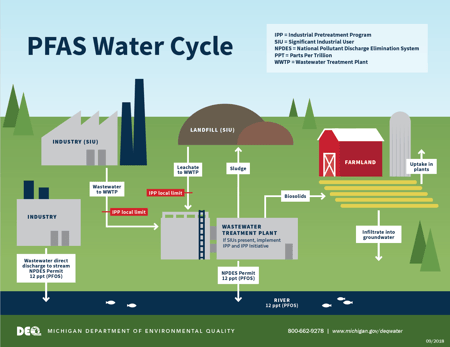 Monitoring municipal and industrial wastewaters is an important part of tracking and managing pollutants. This is particularly relevant for contaminants like PFAS, which can remain unchanged through the wastewater treatment processes. In fact, wastewater treatment plant effluent is a major contributor of PFAS in surface water. Understanding the role that treatment plants play in managing this hazard can help us better understand the affects of PFAS on human health and the environment.
Monitoring municipal and industrial wastewaters is an important part of tracking and managing pollutants. This is particularly relevant for contaminants like PFAS, which can remain unchanged through the wastewater treatment processes. In fact, wastewater treatment plant effluent is a major contributor of PFAS in surface water. Understanding the role that treatment plants play in managing this hazard can help us better understand the affects of PFAS on human health and the environment.
What Are PFAS?
Per- and Polyfluoroalkyl Substances (PFAS) are a group of manmade chemicals that include PFOA, PFOS, GenX and many others. Studies indicate that PFOA and PFOS can cause reproductive and developmental, liver and kidney, and immunological effects in laboratory animals. Both chemicals have caused tumors in animals. The most consistent findings are increased cholesterol levels among exposed populations. PFOA and PFOS, two of the most widely studied PFAS, have been phased out as a result of the EPA’s PFOA Stewardship Program. However, this action has not completely eliminated these types of PFAS, as some U.S. companies may be using existing supplies or may not be participating in this program. In addition, PFOA and PFOS are still allowed in imported goods.
PFAS have been commonly used in the U.S. since the 1940s in industrial processes, such as production facilities or industries, and consumer products, such as food packaging and commercial household products. PFAS are comprised of many chemicals with unique properties that make them heat resistant, water repellent and virtually indestructible. Due to their recalcitrant structure, PFAS accumulate over time, eventually making their way into our wastewater and surface waters. Although these chemicals were widely used, little has been done to manage these potentially harmful compounds, until now.
What’s Being Done to Address PFAS?
EPA recently released a PFAS Action Plan, which provides short- and long-term strategies to communicate the affects of PFAS on public health and the environment, address current PFAS contamination, and prevent further contamination. Working with federal, state, tribal and community partners, the EPA plans to better understand and reduce the risks of PFAS.
As part of the PFAS Action Plan, the EPA is going to take the following key steps:
- Propose a regulatory determination that provides an opportunity for the public to contribute to the regulation of PFAS in drinking water.
- Provide tools to help states and communities address existing contamination and develop cleanup programs that increase accountability.
- Consider adding PFAS chemicals to the Toxics Release Inventory to help manage and reduce the risk of PFAS to human health and the environment.
- Propose nationwide drinking water monitoring to inform regulatory action.
- Improve and expand the scientific foundation responsible for researching, understanding and managing PFAS risks.
- Support communities with enforcement efforts to address PFAS exposure in the environment.
- Develop a risk communication toolbox for federal, state, tribal and local partners to ensure clear and consistent messaging to the public.
How Does PFAS Impact Wastewater?
Although wastewater treatment plants may release PFAS into the environment, getting to the root of the problem by tracing sources of PFAS is of the utmost importance. Many states are following suit with the EPA’s PFAS Action Plan by drafting legislation and other measures to address PFAS. Some states have already started taking robust action, requiring public wastewater plants to identify industrial customers using PFAS, and develop plans to reduce the use of PFAS or discharge. This is giving wastewater plants the opportunity to identify what’s in their system and create a plan to remove it. Overall, we are heading in the right direction by identifying potentially harmful compounds and working toward a solution.
To stay on top of important wastewater industry news, and to receive special insight and tips, subscribe to WinCan’s newsletter.





